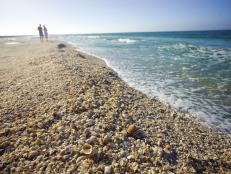Love Oysters? These Restaurants Boast the Best
From bold and briny to delicate and mild, there’s an oyster for every palate. Down them raw with hot sauce and crackers, or serve them baked, grilled or fried. These mollusks may not be the prettiest foods on your plate, but they could be the most delicious.

Oregon Sea Grant
Oysters from all over the world are now cultivated in the U.S., so it's easier than ever to find your favorites. Where they grow has a big influence on how they taste--and so does the season of the year.
In fact, you've probably heard you shouldn’t eat oysters in a month without an “R” in it. That suggested oysters from cold waters were safer to eat, and less likely to be contaminated with bacteria. That was good advice back in the 1900s, says a representative for the East Coast Shellfish Growers Association, but modern sanitation practices have made U.S. oysters among the safest in the world.

Oregon Sea Grant
That doesn’t mean it’s always safe to eat raw oysters. Only proper cooking can destroy bacteria. You should especially avoid raw oysters if you have any health issues, a weakened immune system or if you are pregnant.
Whether you’re a newbie to the joys of oyster-eating or a longtime fan, you'll find there are 5 main species to choose from:
Pacific or Japanese oysters are typically large and sweet, with a buttery or creamy texture and rich, mineral flavor. Native to the Pacific coast of Asia, they're widely farmed on the west coast of the U.S. They're sometimes harvested when they're small, for serving at raw bars.
Kumamoto oysters, like the Pacific types, are widely available on the west coast. The meats inside their deep, bowl-shaped shells are small, with sweet, somewhat nutty to fruity flavors. Kumamotos take their name from the Japanese island of Kyushu, where they originated. They’re a good choice for first-time oyster eaters.
Atlantic oysters, or Virginicas, are native to the east coast and the Atlantic waters from Argentina to Canada. These bivalves are bigger than Kumamotos, with a salty, almost fruity flavor. They include Blue Points, Beausoleils and Wellfleets (although the name “Wellfleet” has been used by so many oyster sellers, it’s almost become meaningless. The same thing has happened to Bluepoints; the name is often used to refer to any Atlantic oyster served on the half shell).

Connecticut Sea Grant
European flats were introduced from Europe in the 1950s, and they're now harvested on both coasts of the U.S. They’re sometimes called Belons, but not all European flats are Belons. True Belons come from the Brittany region of France. They’re the choice of true oyster lovers, because they have a strong taste that’s more mineral-like and seaweedy than briny, and even the biggest oyster fans sometimes say they’re too metallic to eat.
Olympias are the only oysters that are native to the West Coast of North America. These quarter-sized oysters almost disappeared in the early 1900s, because of overharvesting and other issues. Today, wild Olympias are strictly protected, and the ones you buy are usually cultivated in Puget Sound. These delicacies have a strong taste, similar to the European flats.

Deborah Mercy / Alaska Sea Grant
You can find great oyster bars almost anywhere you roam, like these:
Eventide Oyster Co., Portland, Maine
Eventide specializes in Maine-grown oysters, such as Basket Islands, Pemaquids, and Glidden Points, but they also offer a great variety of "away" oysters, including Kusshis, Kumamotos, Katamas and Duxburys. Check the menu, which changes daily.
Boss Oyster, Apalachicola, Florida
Relax on a deck overlooking the river when you visit Apalachicola, a small fishing town, and feast on oysters fresh from the bay. Boss Oyster invites you to customize your own creation; choose how you want your oysters prepared and pick your toppings.
Grand Central Oyster Bar & Restaurant, New York, N.Y.
This well-known spot has one of the largest selections of oysters in New York City, with over 30 varieties. A helpful list guides you to each variety's characteristics, so you'll know whether you're getting oysters that taste mild, sweet, briny, potent or powerful.
Hog Island Oyster Company, San Francisco, California
This oyster farm on Tomales Bay offers picnicking, tours, catering and retail sales. You can also enjoy your oysters on The Boat, the on-site oyster bar, or dine at Hog Island's location in Napa’s Oxbow Public Market.
Gilhooley’s Bar & Grill, San Leon, Texas
Bring cash to this beloved oyster shack outside Houston, because Gilhooley's doesn't take credit cards. Leave the pets and kids at home, too; they're not allowed. There's not even a website--but fans says the oysters make up for everything.
Island Creek Oyster Bar, Boston, Massachusetts
Island Creek changes its list of oysters every day, but you'll usually find at least 12 to 18 kinds on the menu. The owners work with oyster farmers on both coasts, so you may be able to get oysters that aren't normally served in New England, such as Olympias from Washington.
The Original Oyster House, Mobile, Alabama
Try this restaurant's Gulf oysters raw, baked, broiled or fried. They're also delicious served char-grilled on the half shell, basted in garlic butter and topped with Parmesan and Romano cheeses.
Oysters on the Road
If you're on the road, and you buy live oysters to take home, unpack them as soon as you can. To be safe, discard any that are cracked or open. Then re-bag them, cup-side down, or put them in a bowl, so they don’t leak everywhere, and drape a moist paper towel over them.
Keep them refrigerated until you’re ready to use them, or put them on ice in your cooler. Don’t seal the bag or submerge them in water, so they can breathe.
If you’re not sure whether your oysters are still alive, tap their shells with a knife. If the shells don’t close tightly, throw them away.
Shucked oysters should be used no later than the “best used by” date on the label, but go ahead and discard them anytime they smell bad. If the meats look dry and cloudy, instead of plump and glossy, that's also a sign to toss them out.
Can't get enough of these briny bivalves? Search online for "oyster trails," websites that direct you to restaurants, seafood bars, growers and vendors. Here are a few to get you started:
Jefferson Parish Oyster Trail (Louisiana)
Puget Sound Oyster Trail (Washington)










